The Historical Marker Program is one of the PHMC’s most popular public history programs, and the recently approved nominations prove these aluminum markers dotting our roads and city sidewalks are more than just “history on a stick.” The words cast into markers and the marker topics have deep meaning to many Pennsylvanians.
Each year, newly-cast markers are dedicated, and unveiling ceremonies are planned by marker sponsors, nominators, and local officials. PHMC representatives often participate in dedication events and official remarks made on behalf of the Governor note that “each marker establishes an important link to the past” and it is our hope that “the dedication of this marker is not the end of the story but will, instead, provide encouragement for further exploration and discussion.”
I have been honored to represent the PHMC at a few historical marker dedications over the years, but until this year, there has not been a marker connected to my story until the dedication of Sylvania Electric Products in Emporium, Cameron County. At the dedication ceremony for the Sylvania marker, I learned the military and global significance of this industry, which was not based in Philadelphia or Pittsburgh, but rather grew its roots in the woods of Pennsylvania.
Sylvania’s Beginnings
The name Sylvania is of French, Latin origins, which means it has more than one root, woods, or forest. This Sylvania story began in 1907 when a new factory was constructed in Emporium to produce carbon-filament lamps. The site for the new factory is where the investors’ lumber mill had been located. Initially, the company was known as the Novelty Incandescent Lamp Co. and production of miniature specialty and decorative lamps were produced by a workforce of twelve women and two men. More on “girls town” later.
Ownership of the company changed several times for a variety of reasons. The Novelty brand was under ownership of General Motors and then General Electric (GE) between 1910 and 1921, and due to post war depression GE eventually decided to close Novelty.
Local entrepreneurs, Bernard Erskine, Joseph Wortman, and Guy Felt, took a risk during the recession to purchase the assets from General Electric for $350,000 ($1,500,00 in today’s dollars). The company was renamed Novelty Incandescent Lamp Co., or Nilco Lamp Works. All lamp production move to St. Mary’s facilities and Emporium served as general offices.
Looking to diversify their products, the team turned into the radio craze capturing the public’s fancy. Fortunately, the core of a radio set was a “tube” which involved the same manufacturing process as an incandescent lamp. After realizing they were able to transition into the tube business, NILCO’s owners applied to RCA for a license. A new company was formed separate from NILCO and was financed by selling shares at $100 per share. Sylvania Products Company took root in 1924 and quickly began producing a new type of radio tube that contributed to the invention that would change the world, the radio.
Fun fact: In 1928, the company began sponsoring a radio program broadcast to twelve stations nationally. It featured the Sylvania Foresters, an orchestra composed entirely of employees from the Emporium factory. The Sylvania Foresters were among the selections aired on NBC’s Acousticon Hour on Sunday afternoons.
New Emporium Factory
In 1929, a new factory was built in Emporium and radio tubes became a significant part of the Nilco-Sylvania business. A merger with Hygrade in 1931 propelled the company, and the emerging war in Europe stimulated business considerably. Several new and important products were patented, including 105 new types of radio tubes. A significant invention was the Lock-In Tube, developed mainly for mobile applications where vibrations or motion necessitated the need to lock tubes into place. Automobiles, aircraft, and marine radios required this specialty tube. Tube technology continued to evolve under the Hygrade Sylvania label.
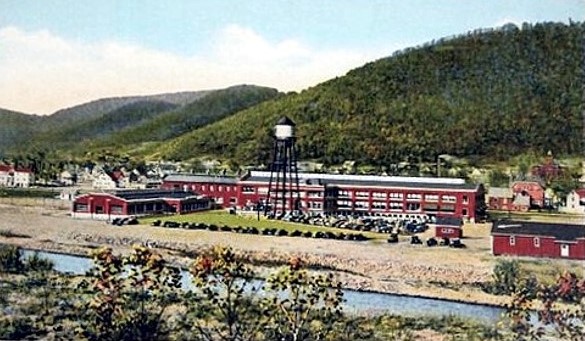
In 1940 the National Defense Research Committee employed scientist and some of the best institutions in the county to begin researching a top-secret project. Their task was to develop a fuse that did not depend on time-to-target calculations or even physical contact with a target. The result was the proximity fuze which sent radio waves measuring the time it would take for the waves to bounce back allowing it to detonate a set distance from an object.
Proximity fuzes are intended to detonate missiles automatically upon approach to a target and at such a position along the flight path of the missile as to inflict maximum damage to the target. Proximity fuzes were fashioned by shrinking down a radio transmitter and receiver until it was small enough to fit into the allotted space.
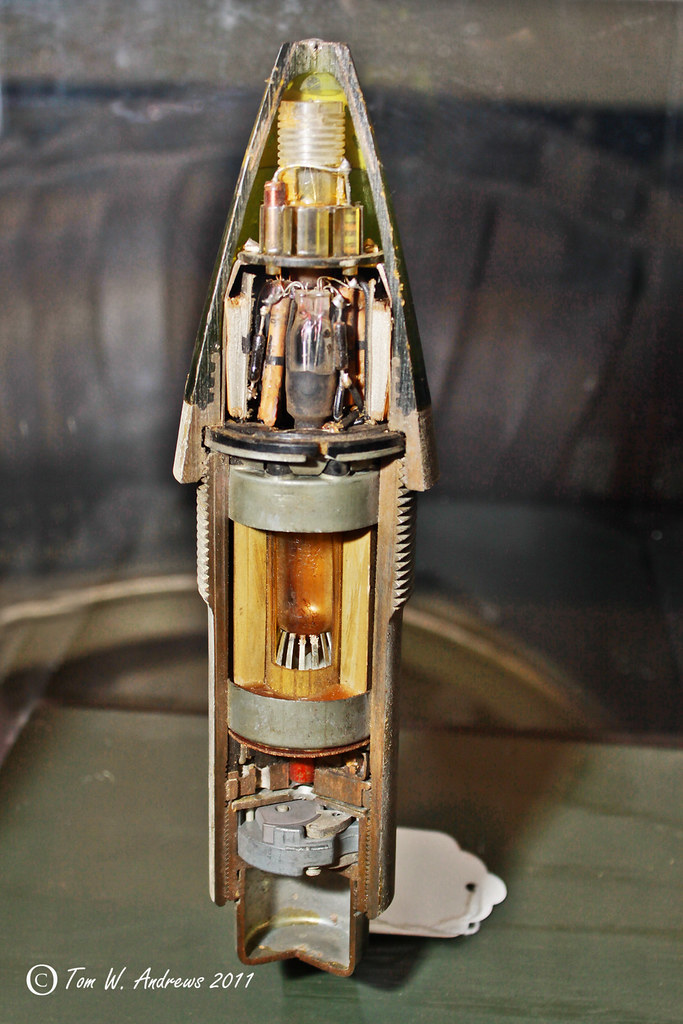
Although the National Defense Research Committee contracted with several other companies to produce a satisfactory design for the proximity fuze, Sylvania was the first to meet all prescribed tests. Within 29 days of contract in the spring of 1942, the first fuzes were shipped. A few months after Pearl Harbor the company switched almost completely to war production and in 1942 Hygrade Sylvania Corp. became Sylvania Electric Products.
WWII and Pennsylvania’s “Girls Town”
Young women from surrounding farms and small towns poured into Emporium to begin working in the factory. An article in Collier’s magazine on November 21, 1942, stated “Boom towns are common place phenomena in every war, but WWII has made quiet little Emporium, deep in the Bucktail Mountains of Pennsylvania, the nation’s first girls town.” It further stated that, “the girls work in the local radio-tube plan of Sylvania Electric, now one of the largest American producers of tubes. The company has employed women since 1904 because men haven’t the patience nor the skill with their fingers that the work requires.” The “Girls Town” article was read around the world and many of the girls featured began receiving hundreds of letters and telegrams.
The weapon the girls helped manufacture in Emporium was such a closely guarded secret that those who worked on the line did not truly know what they were. Sylvania’s proximity fuzes were shipped to Johns Hopkins Medical School labeled as rectal spreaders! The proximity fuze was an important technological innovation in WWII and is credited for turning the tide at the Battle of the Bulge and aiding in the defeat of Japanese Air Force and Navy.
On November 5, 1942, Sylvania received the Army-Navy “E” Award. The Army-Navy “Excellence in Production” (“E”) Award was created in 1942 to recognize industries for their outstanding production contributions to the War and Navy Departments. By war’s end, this recognition was only awarded to 5% of the more than 85,000 companies producing materials for the U.S. military’s war effort.
After WWII the Emporium plant converted production to television picture tubes. By this time Sylvania was buying and consolidating with companies all over the U.S. and in 1954 there were more than 50 Sylvania facilities in 20 states. A merger with General Telephone (GTE) in 1959 transitioned the company’s focus from consumer electronics to precision materials.
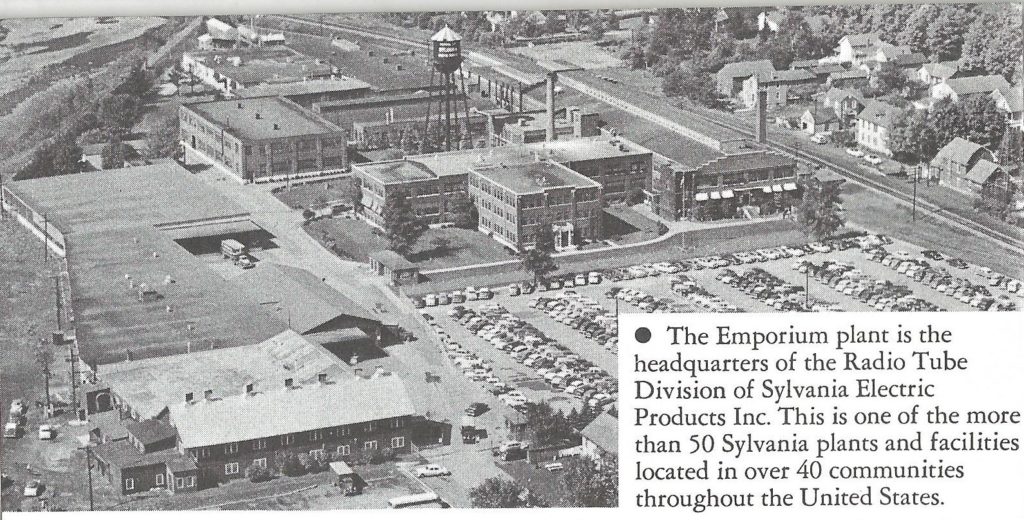
My Sylvania Story
My connection to Sylvania began when my mother started working for GTE Sylvania when I was a young girl. She retired from OSRAM Sylvania 25 years later. During her years working for Sylvania, she earned the nickname “Sylvania Sue” and earned the company’s “man of the year” award in 1991 for her sales achievements. When I was in college moving out of the dorm and into my first rental house my mom packed a box of old Tupperware® to help outfit my kitchen, and she also packed a box – a big box! – of Sylvania light bulbs in all shapes and sizes. I moved that box of bulbs with me to three different states before returning to Pennsylvania. And recently, I used the last little bulb from one of those packs. It worked brilliantly!
On May 29, 2021, I proudly represented the PHMC at the Sylvania Electric Products marker dedication. The rainy day brought out approximately 35 people to hear the history of Sylvania and to witness the marker unveiled. Four participants at the event were former workers at the now closed Sylvania plant in Emporium. Ironically, they were all male.
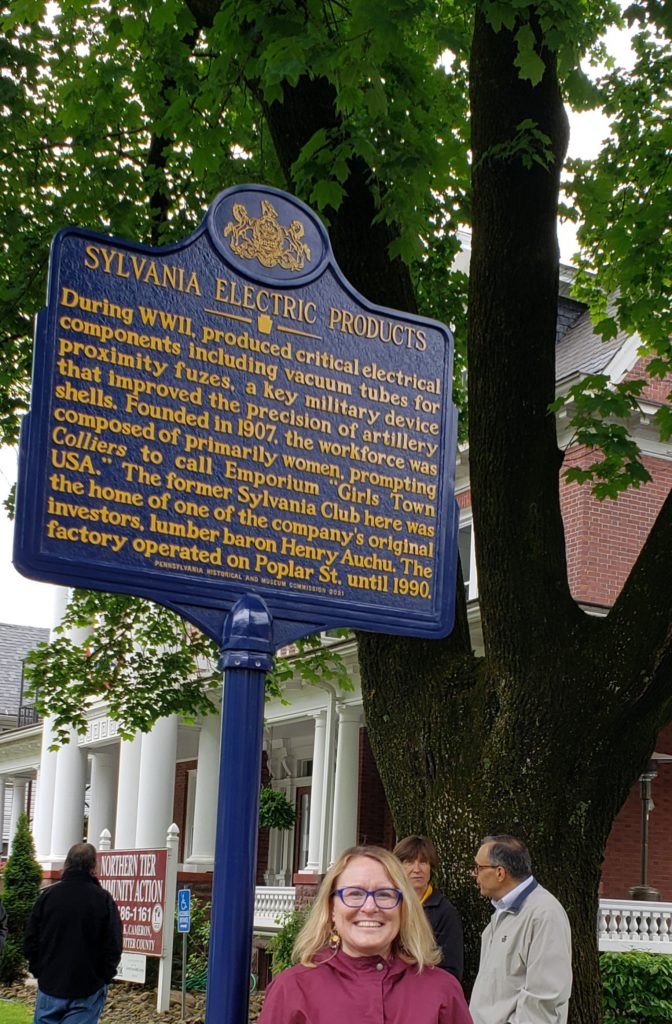
The marker was installed on the lawn of the Sylvania Club on West Fourth Street in Emporium. The historic three-bay building now houses the Northern Tier Community Action Center.
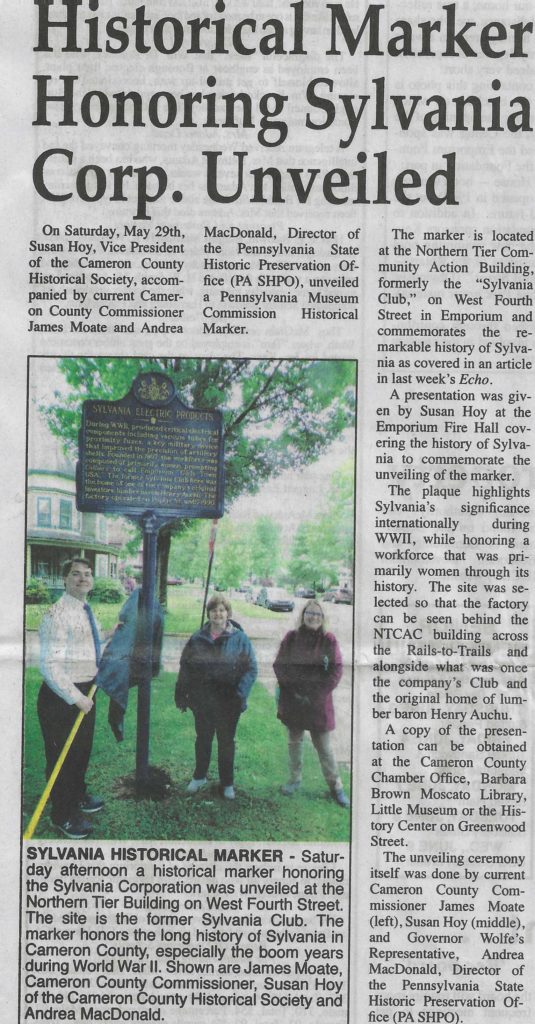
Much of this article, research on the history of Sylvania Electric Products, and images are credited to Susan Hoy, Vice President of the Cameron County Historical Society. There is more to learn about Sylvania too! You can visit the Cameron County Historical Society’s Little Museum on Route 120, about 9 miles south of Emporium.
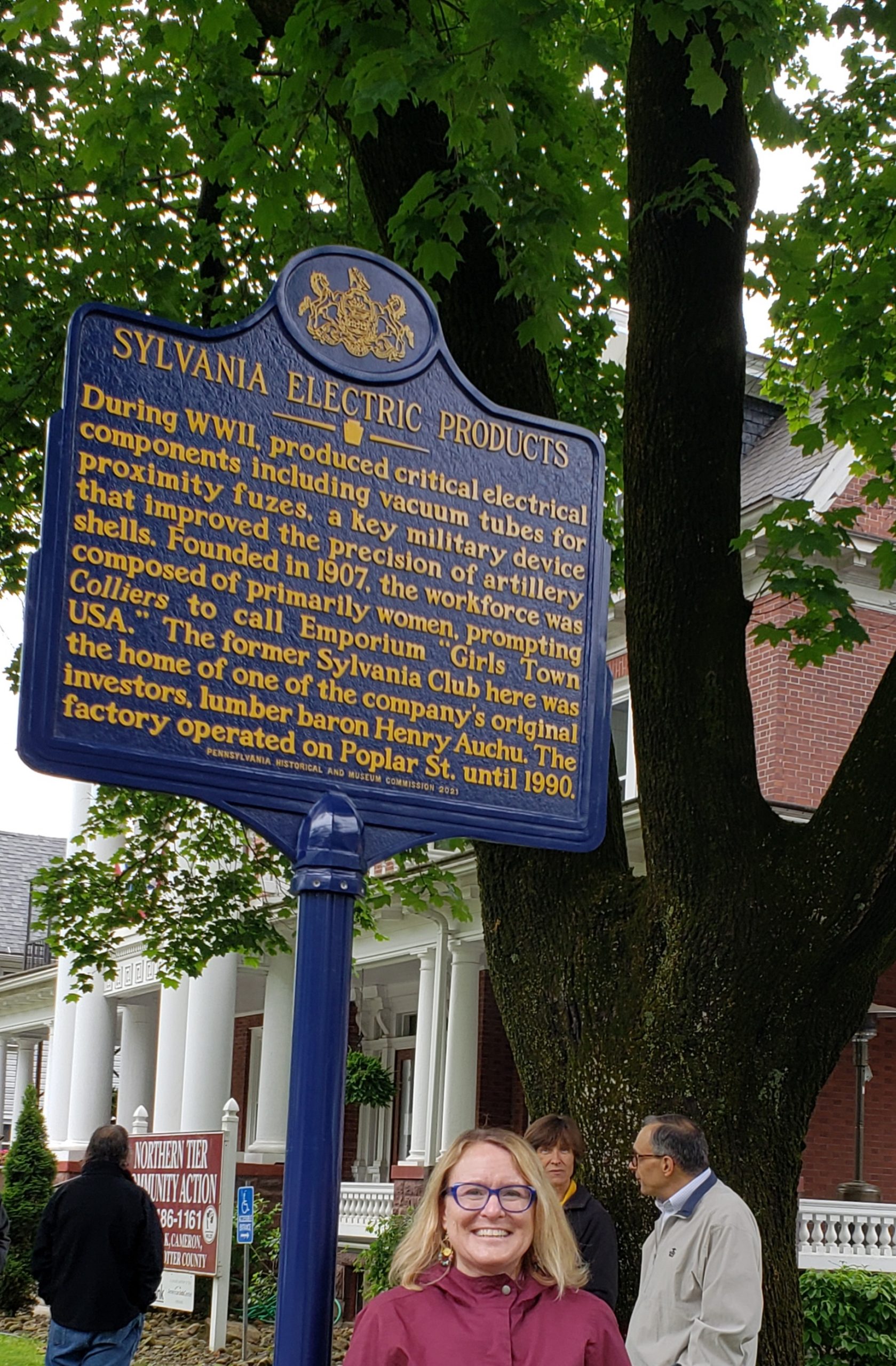
Hi Andrea,
I just want to thank you for writing such an excellent article. I found it of great interest as my company still uses new old stock Sylvania tubes in the effects pedals we make.
Kind regards
Philip
Hello,
I thought you might be interested in another aspect of the work done in Emporium at this Sylvania plant. They appear to have been an important manufacturer/contributor of tubes for the Whirlwind computer. You can read a trip report on the MIT archives at:
https://dome.mit.edu/bitstream/handle/1721.3/39054/MC665_r04_M-913.pdf?sequence=1&isAllowed=y
They also built the 7ak7 tube which was used in construction of the Whirlwind circuits.
https://www.computerhistory.org/collections/catalog/102733048
My mother lives across the street from the Sylvania plant and the beautiful historic society building. I love to visit her.
I agree, Donna, Emporium is beautiful place!
I came across this researching my fathers legacy. As far as I can decider from your fine reporting, this the same Sylvania plant my father, Paul Ernest Larson, worked at as controller in the late 40’s/ early 50’s after he completed his enlistment in the Korean War, pacific theater on the coral sea for the coast guard as what is now designated an atomic veteran. Paul died at the age of 41 of bone cancer. So this is when’s he met my mom, Annabelle Swanson of kersey, Dagus mines Pennsylvania as she was one of the employees at the plant. I love learning that she was part of girls town in the day.
Thank you, James, for sharing your story. I also love learning how places in Pennsylvania’s communities help tell our shared stories. Best wishes to you as you continue your research.
Loved the historical article.
Thanks.
Hi Andrea,
My name is Chelsie and I am working on tracing my ancestry. My dad’s birth father’s father (paternal great grandfather), according to the 1950 census, was 54 and living in Emporium, and was working as an Office Manager at a Radio Tube factory. I understand that the factory shut down in 1990, but seeing as how this is a major part of Emporium’s history, was there any record kept of employees throughout its time in operation? I would be so grateful if you could point me in the direction of where I may find such a record.
Thank you so much in advance for your time!
Hello! Probably the people who could help you are at the Cameron County Historical Society. They have a building on Greenwood Street in Emporium and also operate the Little Museum in Sterling Run. They do have contact information online 🙂 Hope that helps!
Hi, Chelsie.
Thank you for your question. I recommend contacting the Cameron County Historical Society. They have a research center and you can schedule an appointment by calling 814-486-0334.
Best wishes!
Andrea
Hi Andrea,
My apologies, I somehow missed your comment during my last view visits to this page! If I were to make an appointment, it would have to be for an over the phone meeting because I live in the San Francisco bay area. I will nonetheless give them a call, any lead helps.
Thank you!
My parents met in 1952 at the Sylvania in Emporium . . . my mother was a secretary there and had lived in Emporium for the previous eight years (my maternal grandmother also worked at Sylvania as an assembly line supervisor); and my father was a junior engineer who had been sent from California to work at this particular Sylvania. My father was transferred back to California five months later, so my parents got married and moved to Los Angeles (I believe that my mother suffered quite a bit of “culture shock” in L.A. after living in small town Pennsylvania her entire life). I am planning a trip to Pennsylvania soon and will definitely stop in Emporium to see the Sylvania Historical Marker!
Hi Janice,
Did your mom happen to know an Archer Smith? He was an Office Manager at Sylvania back in 1950.
Thank you!
Hi, Chelsie:
I’m afraid that I never heard my mother mention an Archer Smith, and I can’t ask her because she’s passed away. I did, however, ask my dad if he’d heard of your great-grandfather, and unfortunately, he hadn’t.
I’m really sorry that I can’t be of more help. I know how frustrating it is not to be able to find out more about one’s ancestors . . . I’m running into all sorts of roadblocks when it comes to researching my mother’s family, from whom she was estranged.
I hope you have better luck!
Hi Janice,
Thank you so much anyway for responding, let alone asking! Getting answers, even when they are, no, is much better, than never getting a response at all.
Thank you and I wish you better luck as well!
Hi Andrea. Thank you for your article. The photos certainly brought back memories as I lived in Emporium until 16. Roger Slinkman, my father, worked for Sylvania from 1942 until his passing in 1981. He began as an electrical engineer, designing tubes etc. Through family research we believe he was involved with the proximity fuse as well as the atom bomb (why else would there have been so many trips to Los Alamos?) True to his nature and high security clearance, he did not discuss any of these programs with anyone. Nor did any of us know any of this information while he was alive so we are piecing this together. It is so fascinating. In June my two brothers and I are attending the 80th anniversary of Normandy and will definitely be thing of Emporium, Dad and the proximity fuse.
Hi Kerry,
I’m searching for information about my biological grandfather and I know that his father (my great grandfather), Archer Smith worked at the Sylvania factory as an Office Manager, when they lived in Emporium in the 40’s and 50’s. Your father didn’t by any chance know Archer, or ever mention him in conversation? I know its a long shot, but it doesn’t hurt to ask, right?
Thank you in advance!
Hi. I don’t recall the name myself but will ask my older brother as he might. I am hoping he might be of assistant. There is no doubt that my Dad knew him – everyone knew everyone aat the plant. Who knows, I probably was at the same Sylvania family events as him.
Do you know when he retired? There are so few folks from those days. Many of them ended up in Seneca Falls, NY when they entered the television market. I’m not sure who is still with us but I have a contact so I’ll follow up for you.
Hi Kerry,
I do apologize, I didn’t catch that my phone autocorrected your name to Kelly, before posting my latest comment!!
Thank you!
Sorry Kerry, I got so excited by your mentioning about your father working at the factory, that I apparently neglected to read your entire post. Please ignore my previous question, as you clearly stated you knew nothing about his time at the factory.
Hi! Just to clarify, I do know that he worked on new designs for vacuum tubes including a patent. He also worked on the early attempt developing a tubes for the early computer Whirlwind (later disbanded.) I have actually seen the building at MIT where my Dad attended an important meeting regarding this program. There is a historical marker on the building to mark this event (discovered by my daughter who lives in Cambridge.) Also was involved with the design to stabilize vacuum tubes for use in WWII radio communication. I believe that his skills and experience in Emporium were essential in his career path to Manager of Seneca Falls, NY and Ottawa, Ohio tv tube production factories and eventually to President of the company. If you are interested I can look for through old files and see if I have anything from the Emporium days.
Hi Kelly,
Oh my goodness, I am very interested, thank you so much! I know that my great grandfather, Archer Smith, was married to a woman named Claire and they had a daughter named Esther, who was born in 1948. In 1950, the census indicated he worked for the factory as an Office Manager. I also know that Archer passed away in 1966, just before turning 70.
I would sincerely appreciate any information you may have on him, thank you so much again!
Esther was born the same year as my older brother. I’ll have to ask him. I might eben have some old yearbooks I can look t.
This is AMAZING, I can’t thank you enough!!
Hi Chelsie,
I asked my brother if he knew am Esther Smith in classes. He did not. So I referred to referred to the graduating class of 1966 – those born in 1948. Here are all the female Smiths:
Joanne Louise Smith
Patricia Ann Smith.
Also checked the class of 1967 – no Smiths
Also checked class of 19665 – a Joan Patricia Smith
I did some more sleuthing and discovered that an Esther Smith was born in August 1939 and passed the same month. The parents do not match yours: Donald Raymond Smith and Blanche Margaret Cheney Smith
Brief Life History of Esther
When Esther Smith was born in August 1939, in Emporium, Cameron, Pennsylvania, United States, her father, Donald Raymond Smith, was 21 and her mother, Blanche Margaret Cheney, was 23. She died in August 1939, in Cameron, Pennsylvania, United States, at the age of 0.
I did run across a Chester A Smith. Is this any relation?
I talked to my contact from the “good ole days” in Emporium but he didn’t recognize the name.
Sorry I haven’t been much help.
A few things to consider – Did the family live in Emporium or Cameron County or some other area such as St. Marys which is ~20 miles away but in a different county. I think the best bet is to check the 1950 census to verify that Esther is documented followed by the 1960. Was Archer his first or middle name? Was he living in Emporium when he died? I haven’t come up with anything helpful.
Have you used Ancestery? Many libraries have free access
I’ll let you know if I find anything else and please keep posted on any discoveries.
Hi Kerry,
Her birthday was/is December 20, 1948. My great grandfather’s full name was Archer Greenlaw Smith. They definitely lived in Emporium, within walking distance of the factory because the 1950 census lists the address and Esther is listed on there along with Archer and his wife Claire. I’m not sure where Archer died, but I do know that he died in 1966 and that he is buried in NYC.
I got Esther’s birthday from my grandma and the rest of the information from ancestry.com. I am a member, even did a DNA test. I have combed their website dozens of times trying to get information, it’s been challenging.
Thank you so much for gathering all that information for me, I honestly can’t emphasize enough how much it’s appreciated!
I am looking for the old home of Meredith and Anna May Barton. My family and I lived with them for a while in the 60’s . They are deceased now but I am searching for the address of their home where I and my family used to live. I was very young and my Mom cannot remember. If you can find me an address I would be most grateful